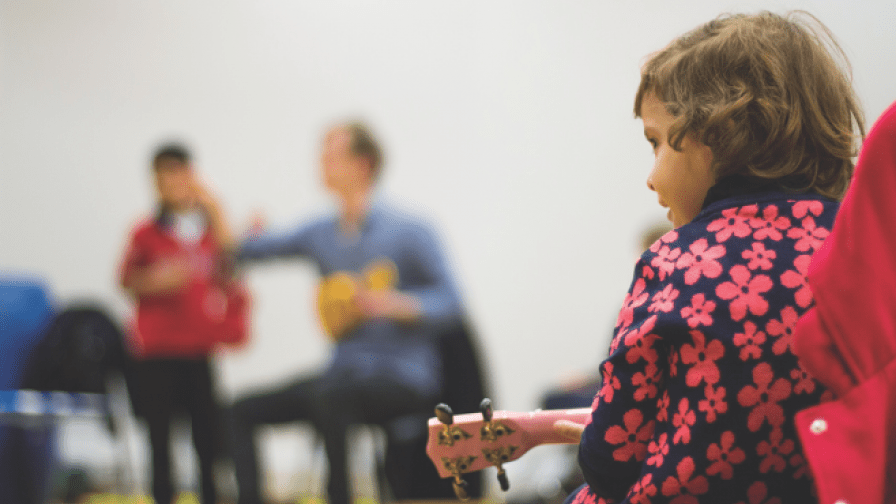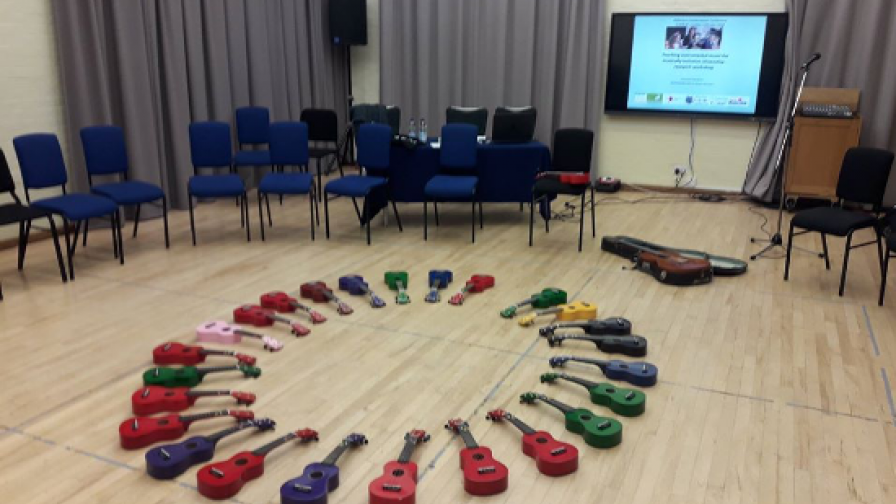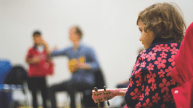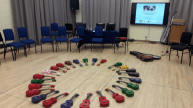An inclusive, creative and social model for whole class ensemble teaching: Hocketing
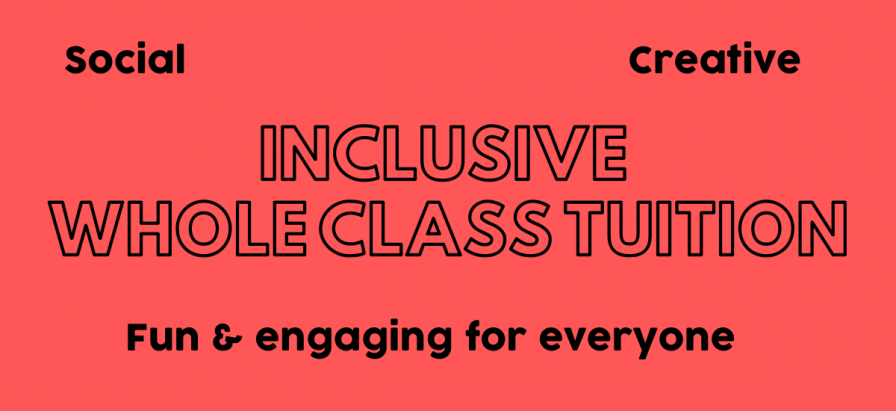
Whole Class Ensemble Teaching/First Access can be a lightbulb moment for young people. It can turn them on to a lifelong love of music, build their self-belief as learners and musicians, and be a joyful, social experience. But it can also offer a challenge to teachers inexperienced to working with mixed ability groups. Developing Whole Class Ensemble Teaching as a more interactive and social experience can make these benefits accessible to all. Michael Davidson, Head of Rock, Family and Community Music at Hertfordshire Music Service explains the ‘one person, one note’ hocketing approach.
With classroom and instrumental music teaching increasingly under pressure in schools, we’re all becoming aware of the importance of advocating for the wider personal and social benefits of music. School leaders are more likely to invest in music work that clearly improve the inclusion, wellbeing and attainment of pupils – particularly those at risk of exclusion.
This is yet to be developed as a major part of instrumental teaching in schools – but whole class teaching offers the obvious route to this.
We’ve been looking into this through our workforce development strand of our MusicNet East inclusion programme, and for the past four years, some guitar and ukulele tutors have adopted an approach called ‘Hocketing’ in their First Access practice. Early responses have suggested that the personal and social outcomes this approach engenders is helping schools value music more highly.
The Hocketing technique is based on musical dialogue. It involves instruments taking turns playing parts of a single melody, one after the other, often in a call-and-response. So, for example, each playing one note of a nursery rhyme or a Christmas Carol. At a more advanced level someone might play do-re-mi; someone else fa-so-la; and someone else, ti-do and then repeat.
You can find hockets in medieval, folk, and community music across different cultures, as they offer a way for many people to play music socially, without spending years learning technique. You can also hear it in all sorts of modern music, from indie rock to electronic dance music and when watching a live performance with musicians on stage passing the melody from one to another, it can make you feel that you’re inside the melody.
Hockets and citizenship in African music
The Venda people of the North Transvaal region in Africa use Hockets as an important rite of passage to adulthood, allocating young people different one-note reed pipes at puberty to demonstrate how cooperation is important, both to make music by each person playing one different note, and for inclusive citizenship. The ‘one person, one note’ hocket approach demonstrates a musical embodiment of the native South African concept of Ubuntu: that ‘a person is a person through other people’. Ethnomusicologist John Blacking once famously compared this humanistic and inclusive approach with the competitive and marginalised way he himself learnt music in Britain, declaring that all people are musical and more human, when musical systems permit them to be so together.
Hocketing ideas for your classroom
Here are a few examples of the ways tutors we’ve worked with have used these socially interactive techniques to develop a playful and creative approach to WCET:
- Demonstrate a right-hand ‘rest stroke’ technique on open strings, and ask pupils to practise this by sending it around and across the circle of learners in turn.
- Ask children their names, play the rhythm to them, then ask them to play it back (or if they’re a little older, or more confident, you don’t need to demonstrate, ask them to show you). This is a good way to get pupils’ attention and engagement, and if there are newcomers, to help everyone to learn each other’s names. It can also help with managing behaviour (strumming someone’s name to bring their attention back to the music class). It also provides material for rhythmic call-and-response warm ups.
- For example, play a simple minor third riff to the class, invite volunteers to play it back.
- Invite volunteers to challenge you to play back a riff they play you. They’re bound to be ambitious and take some musical risks to try to catch you out.
- Allocate different left-hand notes to pairs or trios of pupils. This allows you to conduct scales and tunes across the whole class that the children would struggle to play on their own at the start of the year. Pro Tip: It can help to separate each pair or group of ‘notes’ from the next, to save getting lost and mixing notes up (which happens easily).
- Allocate open strings to less-confident children. This helps to include everyone, and hence to manage behaviour.
- Invite pupils to guess the tunes as they emerge. Twinkle Twinkle Little Star is popular, but rock riffs are also popular and guitar low notes give more scope for this.
- Invite them to suggest tunes for you to conduct.
- As an extension, invite more confident pupils to try using all the notes to work out the tunes on their own.
- Inviting pupils to take a turn shadowing the conductor, then conducting on their own is also always popular, and helps keep people focused.
The power of the circle
Working in a circle is a key part of whole class teaching and much community music, and it’s really powerful. It can help participants achieve more than they can on their own, by offering fun, support and energy. It also gives pupils a chance to learn from watching others playing their note, before it comes to their turn.
With the introduction of left hand notes, returning to passing notes around or across the circle now offers a way to improvise simple tunes and riffs from social interaction. Pupils of all levels of ability and confidence can also enjoy conducting improvised tunes and riffs by bringing in and dropping out groups of notes in turn.
Simple accompanying ostinati played by the tutor can help anchor the rhythm, and provide additional musical interest. Breaking the circle into groups offers a way for pupils to develop and refine collective hocket riffs that can be recombined sequentially or as layers of a larger group piece. When more notes are mastered, breaking pupils into pairs can help them develop a sense of phrasing for composition by improvising musical conversations.
The benefits of Hockets
Instrumental technique: Hocketing certainly supports instrumental technique that supports pupils to continue in subsequent years. But we hope it also builds social connection, through shared rhythm and taking turns – and agency, through learning to improvise and compose. Pupils continuing in Year 5 have gone on to compose material for subsequent First Access Year 4 cohorts.
People skills: They’re also learning how to use music to help people feel included (of much relevance to schools tasked with promoting the Prevent and British Values agendas), and how to take a lead. Music leadership is valued as highly in participatory music cultures (such as Ghanaian Ewe drumming) as ‘presentational’ music cultures value the development of instrumental technique measured by grades.
Creativity, risk-taking and resilience: Pupils are learning improvisation in groups from an early age which can help children develop both creative and collaborative skills and resilience, to help manage the fear of making mistakes that test-based cultures can engender. The improvisatory approach of Hockets helps participants become absorbed in the session, and turn-taking helps everyone feel included and musical.
Engaging families: At Hertfordshire some tutors have been developing this through the extension of First Access into Family Music projects, where pupils teach their parents what they have learnt in First Access. Schools particularly appreciate how this helps them engage families informally, especially hard-to-reach parents, who may have intergenerational disengagement from school and whose children sometimes struggle with formal learning.
Teaching music musically: Beyond promoting personal and social outcomes, we hope that the workshop is helping to demonstrate how musical inclusion pedagogy can offer effective ways to teach music musically. Playing individual notes across a group could offer a way to teach tone row serial composition from an early age. Learning music skills in informal group music-making can help pupils experience and internalise musical concepts, as well as raising enthusiasm for playing.
Behaviour: Perhaps most helpfully, a Hockets-based approach can keep everyone engaged at a level they are comfortable with, absolutely key to avoiding disengagement and challenging behaviour, so helpful for including all pupils, and building confidence for tutors new to group work. One Essex Music Service Tutor we worked with commented “This is gold dust for managing behaviour!”
Could a Hockets-based approach be adopted by tutors of other instruments and to other genres? We can’t see why not. Perhaps the ‘light bulb’ moment could apply to school leaderships’ understanding of the value and impact of music, as much as pupils’ understanding that they can be successful at music?
Michael Davidson is Head of Rock, Family and Community Music for Hertfordshire Music Service, which is a founder member of the Alliance for a Musically Inclusive England. The project is the focus of his PhD research supervised by Angela Impey and Lucy Duran at SOAS, London. Hertfordshire’s MusicNet East programme helps music services to become more inclusive by providing a peer network, resources and tools, and funding for action research on the barriers and drivers to inclusion. Find out more here: www.musicnet-east.org.uk
Interested in bringing different approaches to your whole class lessons? See our video of musical warm up exercises.
Find out how one music tutor from Essex is using hockets in his whole class guitar teaching.
Photos: Rory Davidson


